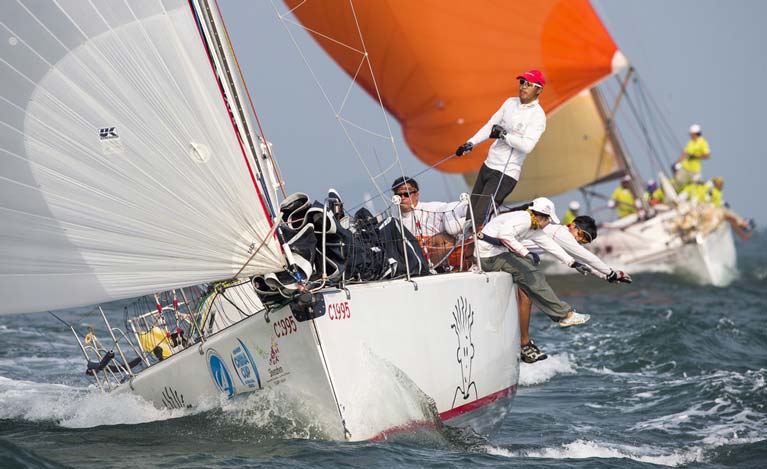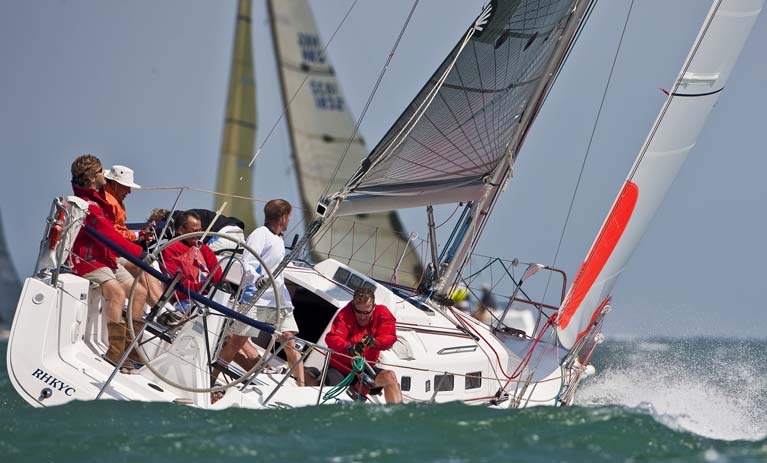Barry Hayes from UK Sailmakers Ireland gives his top tips on how to be the best bowman
Any bowman worth his salt is fast on his feet, strong as an ox, and agile enough to climb the mast. The bowman is also the first to arrive at the boat and last to leave. Consider this about the bowman's role: there are very few changes or evolutions that happen during a race aft of the mast; they all happen forward in "bowman territory." The bowman must be prepared to deal with any call that's made from the afterguard and prepared to cope with any mishap that happens. Here are some top tips for a bowman spending the season on the pointy end.
 The bowman must be prepared to deal with any call that's made from the afterguard
The bowman must be prepared to deal with any call that's made from the afterguard
1. Wear the right clothes
If you don't go out suited and booted then you're coming home wet. A smock/spray top with closures at the collar, wrists, and waist-worn over layers is the best option to you stay dry. It's light and you can fit into any area without wearing a big offshore jacket. Non-adjustable trousers are a must as are shoes that stick to the deck. (Never consider going barefoot!). Test the shoes well before buying. A soft rubber sole is best, and boots with gaiters are the best option for offshore. Most of all, have dry socks if you're wearing shoes or boots.
 Spinlock harness
Spinlock harness
2. Must-have gear
The best harness in the business is a rock-climbing harness. Which you can get from Spinlock. These are light and simple to use. And excellent on the backs of your legs as they are wide. It's also vital to have hanging from your harness:
- A Leatherman skeletool
- An aluminium fid for spiking snap shackles
- soft shackles (different sizes)
- A roll of rigging tape
Going offshore, I prefer to wear a drysuit rather than traditional foul weather gear. I unzip it when I am below, and I'm always dry on deck. It's quick and straightforward and you can be on deck in seconds. A good quality suit means you can get out on the bow and now worry at all about being wet in any shape or form. They fit well with the latest life jackets.
3. Prep your boat
A good bowman will be first on the boat and last off, so he's ready for the next day's sailing. It's a bowman's job to check that all your luff tapes are stacked correctly and that the spinnakers are packed and prepared to go. Clean any furlers, check running rigging, and get it all prepped and ready before the rest of the crew arrives to a clear boat.
 It's a bowman's job to check that all your luff tapes are stacked correctly and that the spinnakers are packed and prepared to go
It's a bowman's job to check that all your luff tapes are stacked correctly and that the spinnakers are packed and prepared to go
4. Before the start
Have a thorough conversation with the tactician and helm well before the guns start firing. Review your starting sequence hand signals. Discuss the course, work out what sails will be needed, when and why. Getting angles for these sails will also help in terms of stacking sails below and pre-setting leads on the deck. If you're going upwind then changing to a code zero and later on to an Asym it will dictate a particular bow choreography. And those steps are up to you to take as the bowman. Perhaps you have the code zero plugged into starboard, and the kite plugged into port before the race has even started; you've already discussed this with the afterguard. I always try and hoist my code zero to windward and get it set ready to go before the start drop it back down, available for the first mark.
5. The start
Your job is to work with the helm and tactician to get the boat into the best position possible (and not over the line) when the gun goes off. Getting a good start is 90% of the race. Having clear communication with the helm is critical. With clear eye contact (tell the crew on the rail to hike out), hand signals are crucial if you don't have a headset on which are very common on big boats these days. Finger pointing up for come up, pointing down for down, fist for hold, hand opening for ease, hand closing for tighten. You need to know your boat lengths; practice a few approaches and get your lay lines and line sights before the start.
 The least amount of time spent on a bow the better; keep your eyes open and focus on your job
The least amount of time spent on a bow the better; keep your eyes open and focus on your job
6. Plan ahead
Before you rush to deal with something that comes up unexpectedly, think ahead about what needs to be done and be prepared. The least amount of time spent on a bow the better; keep your eyes open and focus on your job. Most pro bowmen spend less than 1.40 seconds on the bow in any windward-leeward race; aim for this target. Plan ahead, do quickly what needs to be done and get off the bow.
7. Always hold on
Nothing in this job is worth your life. It's great fun, but being clipped on with a good life jacket is worth everything. I use a carabiner with a short strop to my harness when I am working in heavy weather. I can quickly clip on and not worry about being washed away by a big wave.
8. Always look up
Whichever boat you're on, masthead or fractional, fast or classic, take time to learn which halyards are going where, make sure they are free to run. Make a drawing and determine which halyards do what with which sail like a 2:1 code zero halyard. If you cross a halyard in a change, then don't waste time uncrossing it; instead plan your next sail change so you can uncross it. I always leave the spinnakers halyards on a 2 ft strop higher up off the deck then the genoa halyards whereby they never get mixed up at night when you go to get one.
 Working with people without shouting is the objective
Working with people without shouting is the objective
9. Communication is key to your job
Working with people without shouting is the objective. I always call the name of the person you want to address before you tell him or her what to do. If you say, Bob, (pause till he's looking at you) ease the tackline," is much more effective communication. Plus (theoretically) only Bob will leave the rail to ease the tackline and not half of the crew!
10. Understand how vital the pit person is to a bowman's success
There is a secret kept between the bow and the pit: they run the boat. The afterguard may point the boat in one direction or the other, but the manoeuvres don't work unless the bow and pit are working in concert. Having a very tight bond with your pit person is key to your role.
Remember, be prepared, anticipate, have your gear ready, stay in control of "your bow," and communicate effectively, no race is won without a bowman.
 Manoeuvres don't work unless the bow and pit are working in concert
Manoeuvres don't work unless the bow and pit are working in concert



























































